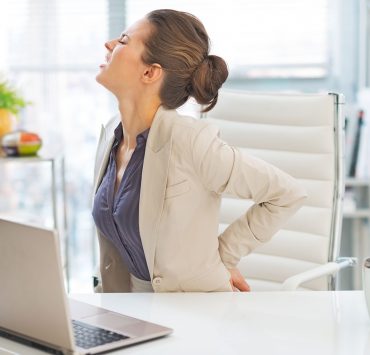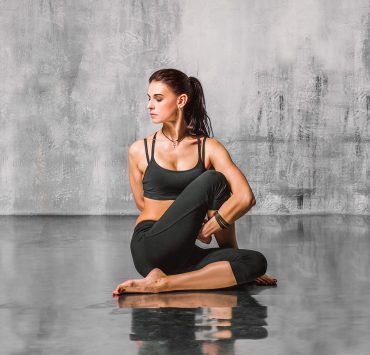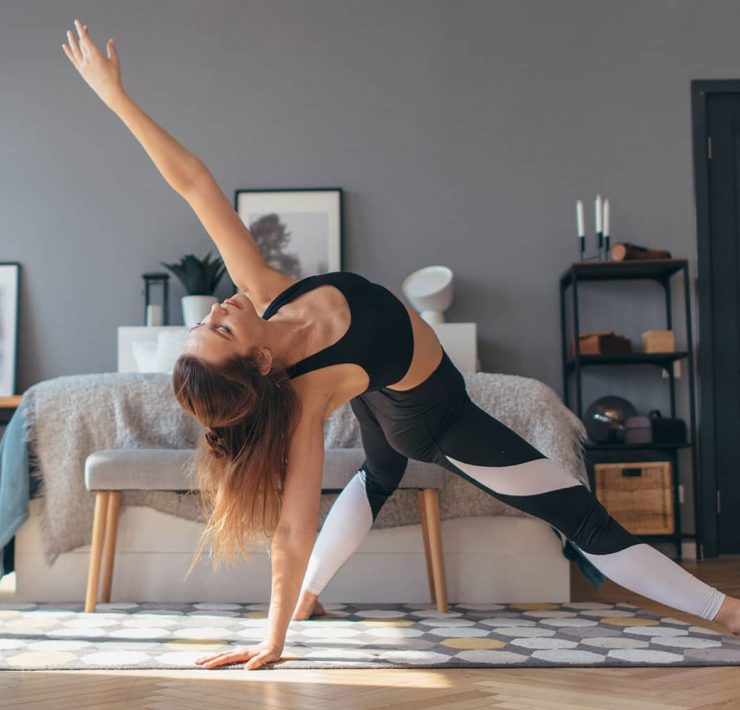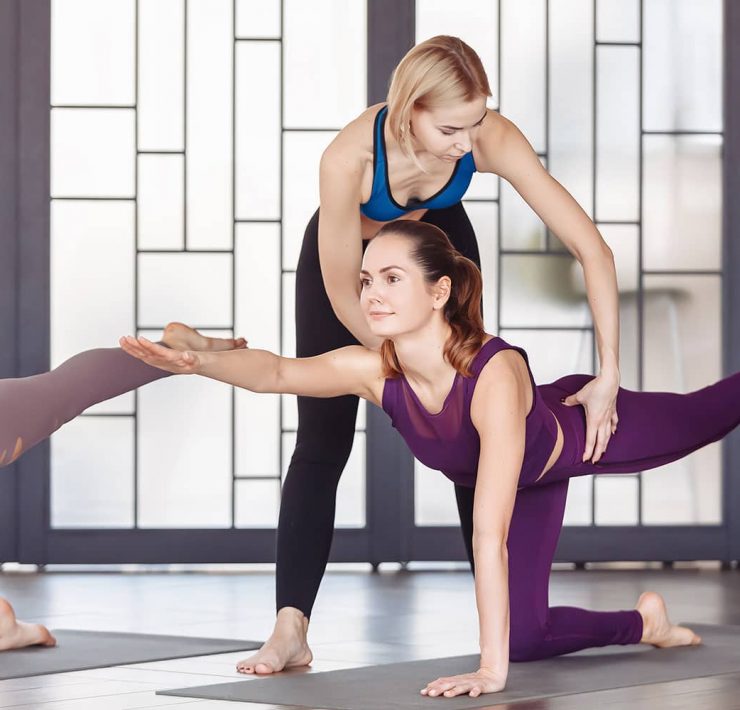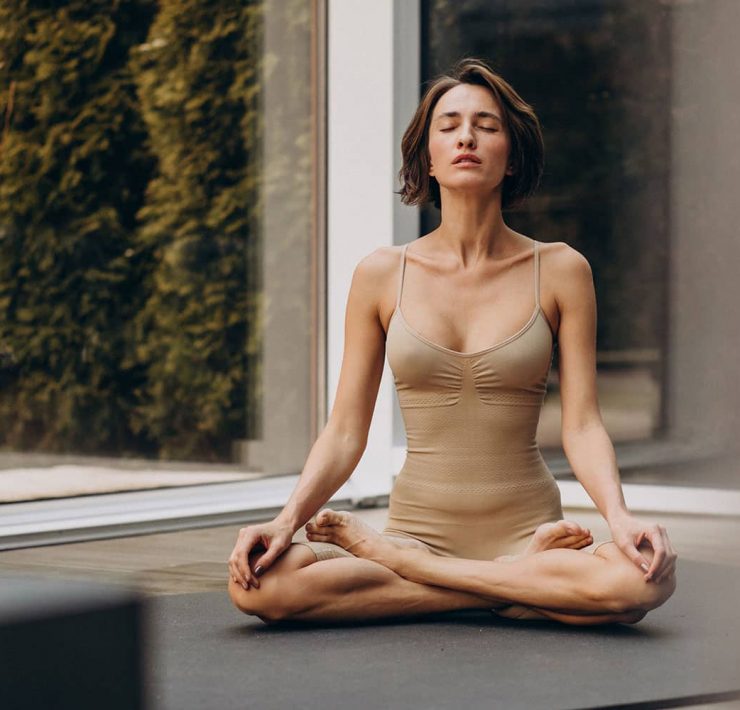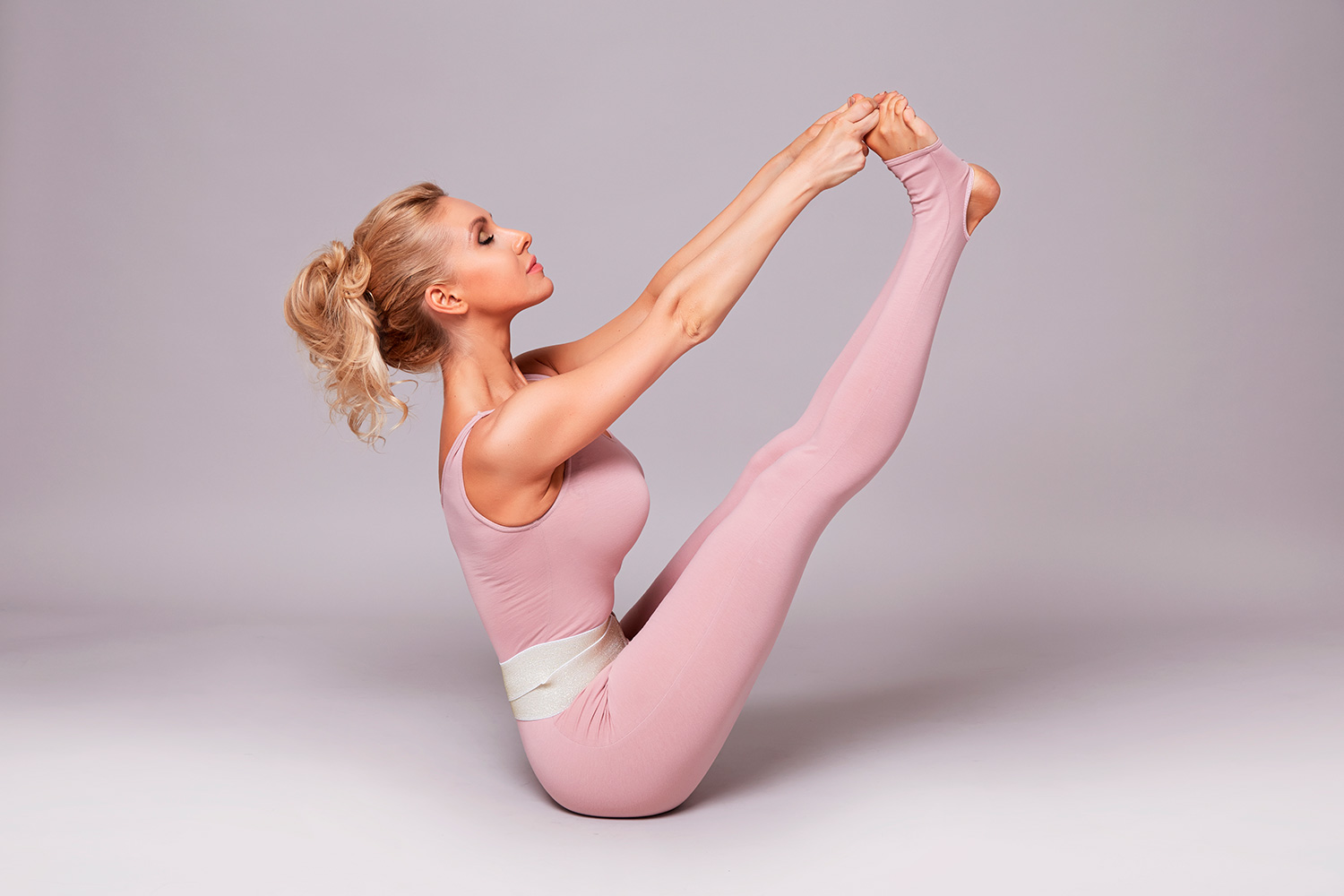
After spending nearly two decades as a relationship therapist, Patricia…
Hatha is the umbrella term used for many yoga practices in western culture and includes popular classes such as vinyasa, power and restorative yoga. This inclusive style of yoga highlights the use of physical postures and breathwork as a means of calming the body, mind, and soul. ‘Ha’ means sun and ‘Tha’ means moon – Symbolic of the union between the solar and lunar, or masculine and feminine, energies within each of us. With the regular practice of Hatha yoga, practitioners take tremendous strides towards inner happiness, balance, and clarity.
Whether you’re new to yoga or a seasoned practitioner, these fundamental postures create the framework for various styles. Focus on slow, mindful movements with proper alignment to support your body. Controlled breathing plays a key role in the practice of Hatha yoga – Inhale to expand or lengthen, and exhale to surrender or deepen.
So wherever you are on your yoga journey, Hatha is either a great place to start or an excellent way to revisit some basic postures.
Tadasana — Mountain Pose

Sanskrit Name: Tadasana
What it’s good for:
Tightens abs and glutes
Reduces flat feet
Soothes sciatica
Improves posture
Strengthens ankles, thighs, and knees
Contraindications:
Insomnia
Headache
Low Blood Pressure
Pregnancy (take a wider stance)
How to:
Stand tall with your big toes together and your heels slightly apart.
Raise the toes from the floor, spread them wide, and set them back down.
Ground down through all four corners of the feet.
Activate the legs by drawing the kneecaps up the thighs.
Broaden the sit bones by internally rotating the thighs.
Move the belly in and bring attention to the natural curve of the spine.
Place the shoulders directly over the pelvis and expand across the chest.
Let the shoulder blades descend down the back.
Hang the arms by your sides with palms facing forward.
Keep the neck long, the gaze forward, and the crown stretching skyward.
Take 10 deep breaths.
Vrksasana — Tree Pose

Sanskrit Name: Vriksasana
What it’s good for:
Improves balance
Strengthens core, spine, thighs, calves, and ankles
Stretches chest, shoulders, groins, and inner thighs
Soothes sciatica
Reduces flat feet
Contraindications:
High blood pressure (don’t raise arms overhead)
Low blood pressure
Headache
Insomnia
Knee or hip injuries
How to:
Stand at the head of your mat and slowly begin to shift weight into your right foot.
Lift your left foot off the ground and place the foot on your right ankle, calf, or inner thigh.
Let the left knee open back to release tension in the hips.
Keep your right leg straight without locking the knee.
Press your hands together at heart center or lift them overhead as you breathe for thirty seconds.
Uttanasana — Standing Forward Fold Pose

Sanskrit Name: Uttanasana
What it’s good for:
Stretches hamstrings, hips, and calves
Relieves stress, anxiety, and tension
Stimulates liver and kidneys
Improves digestions
Soothes symptoms of menopause
Relieves headache and insomnia
Strengthens thighs and knees
Contraindications:
Back injuries
Glaucoma
How to:
From a standing position, hinge forward at the hips and let the arms go heavy towards the floor.
Lengthen the front torso away from the groins as you move deeper into the fold.
Place fingertips or palms on the floor in line with the toes.
Keep a gentle bend in the knees.
Engage the legs to loosen the lower back.
Move your weight towards the toes to arrange the hips over the ankles.
Allow the head and neck to hang heavily towards the floor.
Take ten full breaths here.
Adho Mukha Svanasana — Downward Facing Dog Pose

Sanskrit Name: Adho Mukha Svanasana
What it’s good for:
Stretches hamstrings, shoulders, hands and calves
Strengthens legs, back, core, and arms
Relieves back pain and headaches
Improves blood flow to the brain
Reduces stress and fatigue
Prevents osteoporosis
Soothes symptoms of menopause and menstruation
Improves digestion
Contraindications:
Wrist injuries or carpal tunnel syndrome
Pregnancy (third trimester)
High blood pressure
Diarrhea
How to:
From a tabletop position, tuck your toes and press down through the hands to send your hips up and back.
Straighten the legs and spread the fingers wide.
Roll the forearms in and the biceps out.
Let your head and neck unwind as you draw the shoulder blades down the back.
Engage your legs to take weight out of the arms.
Surrender your heels down, tip your tailbone towards the ceiling, and internally rotate your thighs.
Take five deep breaths here.
Salabhasana — Locust Pose

Sanskrit Name: Salabhasana
What it’s good for:
Improves spinal mobility
Stretches and strengthens back, glutes, calves, hamstrings, and core
Energizes the body
Improves posture
Aids digestion
Relieves stress
Contraindications:
Back or neck injuries
Headache
Pregnancy
How to:
Lie on your belly with arms by your sides and palms facing down.
Rest your third eye center on the mat and plant the tops of the feet down.
Roll your shoulders away from your ears to open across the chest.
Inhale to raise your upper body off the floor, stretching your arms towards the wall behind you.
Lift your knee caps from the floor by engaging the legs.
Stay here for five breaths.
Setu Bandha Sarvangasana — Bridge Pose

Sanskrit Name: Setu Bandha Sarvangasana
What it’s good for:
Stretches the neck, chest, and spine
Promotes the parasympathetic nervous system
Alleviates stress and mild depression
Improves posture and flexibility
Relieves back pain
Relieves menstrual discomfort
Eases tired legs
Contraindications:
Recent back injury
Neck or knee problems
Glaucoma
High blood pressure
How to:
Lie on your back with knees bent, feet flat on the floor, and arms down by your sides.
Reach your fingertips towards your heels and plant your palms down firmly.
On an inhale, press through the hands and feet to lift the hips and torso off the mat.
Keep your arms as they are or interlace your hands and press the forearms down.
Hold for five to ten breaths before lowering down one vertebra at a time.
Virabhadrasana II — Warrior II Pose

Sanskrit Name: Virabhadrasana II
What it’s good for:
Tones the abdominal muscles
Strengthens the arms, ankles, and legs
Opens the chest, groins, and shoulders
Increases stamina
Relieves backaches
Contraindications:
High blood pressure
Diarrhea
Chronic neck or back issues
How to:
Stand at the front of your mat and take a wide step back with your left foot.
Turn your left foot out and right toes straight ahead, lining the front heel up with the back arch.
Inhale your arms out in a T-shape and gaze beyond your right fingertips.
Exhale to bend deeply into the right knee, stacking it directly over the ankle.
Keep your spine straight up from the pelvis as you take five breaths here.
Viparita Virabhadrasana — Reverse Warrior Pose

Sanskrit Name: Viparita Virabhadrasana
What it’s good for:
Opens the side body
Strengthens the legs
Improves core strength and balance
Stretches the hamstrings, quadriceps, groins, shoulders, and hips
Energizes the body
Contraindications:
Difficulty with balance
Hip, knee, back, or shoulder injuries
How to:
Begin in Warrior II with your right foot forward.
Shift your torso towards the front of the room and then sweep your right arm towards the ceiling.
Lengthen your left arm down the back leg.
Keep bending into the front leg as you breathe space in the right side body.
Bring your gaze up to meet the right hand.
Hold for five breaths on each side.
Virasana — Hero Pose

Sanskrit Name: Virasana
What it’s good for:
Stretches and improves flexibility in quads and ankles
Allows for better breathing
Improves posture
Relieves gas
Strengthens arches
Therapeutic for high blood pressure and asthma
Contraindications:
Headache (use a bolster)
Heart issues
Knee or ankle problems
How to:
Find a comfortable seat with knees together and ankles framing the sit bones.
Use a block under the sit bones as needed.
With both sets of toes pointing straight back, press the tops of the feet down.
Rest your hands on your lap and relax the shoulders.
Stay here for one minute.
Dhanurasana — Bow Pose

Sanskrit Name: Dhanurasana
What it’s good for:
Stimulates abdominal organs
Improves posture
Stretches front line of the body
Strengthens back muscles
Contraindications:
Migraine
Insomnia
High or low blood pressure
Back or neck injury
How to:
Lie flat on your belly with feet at hip-distance and both arms flat by your sides.
Bend the knees, flex the feet, and stretch your hands back to take the outer edges of the feet or ankles.
Inhale to gently raise your chest off the ground by pushing the feet into the hands.
Take five deep breaths before releasing down to the floor.
Baddha Konasana — Bound Angle Pose

Sanskrit Name: Baddha Konasana
What it’s good for:
Opens hips and groin.
Stretches thighs, knees, and hip flexors.
Relieves depression, fatigue, and anxiety
Stimulates heart and promotes circulation
Relieves symptoms of menopause and menstruation
Contraindications:
Groin or knee injuries
How to:
Find a seat with soles of the feet together and knees wide.
Use a block under the sit bones as needed.
Draw your heels in as close to the sit bones as is comfortable.
Using your hands, press the outer edges of the feet together.
Sit tall and move the shoulders away from the ears.
Hold for one to three minutes.
Dandasana — Staff Pose

Sanskrit Name: Dandasana
What it’s good for:
Stretches hamstrings, shoulders, chest, and calves
Improves posture
Relieves sciatica pain
Strengthens back muscles
Contraindications:
Wrist or back injuries
How to:
Sit with both legs extended straight ahead.
Ground down through the sit bones by removing and extra flesh.
Flex your feet and engage the thighs, drawing the kneecaps up.
Relax the shoulders as you stack them directly over the hips.
Place the palms on both sides of your hips.
Inhale to maintain length in the spine.
Take five deep breaths.
Bhujangasana — Cobra Pose

Sanskrit Name: Bhujangasana
What it’s good for:
Increases spinal mobility
Relieves back pain
Strengthens back muscles
Opens the front line of the body
Stretches chest, lungs, shoulders, and abdomen
Stimulate abdominal organs
Relieves stress and fatigue
Therapeutic for asthma
Soothes sciatica
Contraindications:
Back, arm, or shoulder injuries
Carpal tunnel syndrome
Pregnancy
Headache
How to:
Start lying on your belly with palms planted under the shoulders.
Root the tops of the feet down.
Direct your elbows straight back and hug the arm bones in towards your body.
Anchor your pubic bone down to the floor.
As you inhale, roll your shoulders back and lift the chest from the floor.
Keep your neck neutral and low ribs on the floor.
Hold for one full breath before exhaling back to the floor.
Salamba Balanasana — Child’s Pose

Sanskrit Name: Balasana
What it’s good for:
Stretches back, hips, thighs, and ankles
Relieves back pain
Soothes stress and fatigue
Contraindications:
Knee injuries
Pregnancy (take a wider stance or use props)
Shoulder injuries (keep arms by your sides)
Diarrhea
How to:
Come to all fours.
Spread your knees just wider than hip-width while pressing the big toes together.
Lengthen your arms forward as you melt your forehead into the mat.
Let the belly release between the thighs.
Continue to rest here and connect to the breath for as long as you need.
Trikonasana — Triangle Pose

Sanskrit Name: Trikonasana
What it’s good for:
Strengthens legs
Stretches groin, hamstrings, hips, shoulders, calves, spine and chest
Improves balance and stability
Stimulates abdominal organs
Releases stress and tension
Improves digestion
Reduces symptoms of menopause
Contraindications:
Back, neck, hip, or shoulder injuries
Headache or migraine
Diarrhea
Low or high blood pressure
Heart conditions
How to:
Stand at the head of your mat and step the right foot back into a wide stance with the foot turned slightly out.
Lift your arms straight out in a T-shape.
Point your left toes towards the front of the mat.
Exhale and reach your left fingertips straight over the front leg.
Place your left hand on your shin, ankle, or a block inside your front foot.
Extend your right arm towards the ceiling.
Hold for thirty seconds on each side.
What's Your Reaction?
After spending nearly two decades as a relationship therapist, Patricia journeyed down the path of writing as a vehicle for sharing her wisdom. Her work reflects a sincere interest in readers’ wellbeing and is abundant with helpful advice and fascinating insight.






